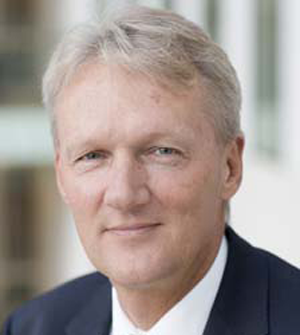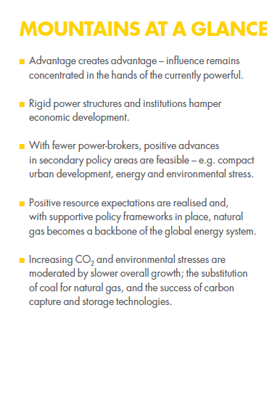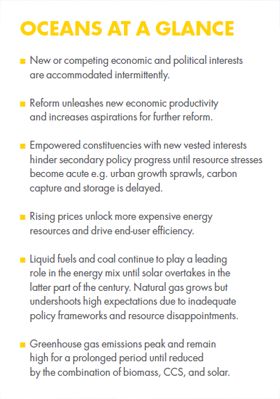Collaboration is Shell's strategic answer to future volatility
on
Collaboration is Shell’s strategic answer to future volatility
With its recently published New Lens Scenarios, Shell provides contrasting visions of the future in the decades ahead. In the foreword, the company’s CEO Peter Voser indicates what may emerge: “We expect demand for critical resources, like water, energy and food to have risen by 40% - 50% by 2030. To meet those needs without significant environmental detriment, business as usual will not be an option – we require business unusual.”
 |
| Wim Thomas, Chief Energy Advisor: “We have horses for courses.” |
To help get a sharper focus on the emerging landscape in the decades ahead, Shell’s scenario planners employed various “lenses”, including three paradoxes of prosperity, connectivity and leadership and two panorama lenses, or scenarios, called “Mountains” and “Oceans”.
The prosperity paradox describes how the global rise in prosperity is both improving living standards while at the same time, undermining the benefits that prosperity brings through various environmental, political and financial stresses. There is a real warning in this: the scenarios reveal that beyond a point, increasing prosperity may not raise subjective well-being, which can even decline.
The connectivity paradox lies within the adverse relation between individualism and collectivism in a globalising world. Connectivity facilitates individual expression and empowerment, but also encourages herd behaviour and amplifies swings in confidence and demand. This is being experienced already almost daily, and as the scenarios point out, a lone hacker that can disrupt the functioning of large business and government enterprises.
The leadership paradox describes required co-ordination among increasing constituencies of decision-makers. The more people and groups involved, the more that vested interests can block progress. It is the gap between the individual, and group and state interests and the need for new forms of collaborations on a more global scale in order to solve problems and get solutions for issues that have neither country boundaries nor limited local impacts.
There’s one certainty about the future; it will be different.
These paradoxes form a pattern of consistency throughout the two main scenarios called “Mountains” and “Oceans”. Despite the unmistakable complexity, the Shell analysis shows that there is room to manoeuvre. The future is not bleak or dark, but is challenging everybody to find the right pathways and the strategies to reach goals that will be acceptable for the world as a whole. The scenarios must not be seen as an easy platform for developing strategies, because both scenarios have positive and troubling elements. This is what Wim Thomas, Chief Energy Advisor of Shell, has to say to this respect.
 |
 |
Comparisons of the two scenarios in short show the differences. Neither scenario will occur unaltered and can act as a descriptive pathways for the future. If the readers allow me this metaphor, they will unfold themselves more like a double helix and act as recipes. And lead in reality to multiple outcomes in accordance with the circumstances, formed over time by policies, social and economic feasibilities, the technological possibilities and collaboration with a strong passion for harmonisation.
For those less familiar with scenario thinking, the analysis makes it clear that the lenses represent not THE vision on the future of energy but A vision as a result of a grand mixture of facts, signals, developments and paradoxes. Choices will be made following the pathways paving and directing them going along. These choices will still need to be made concrete via strategies of governments, institutions and business. However, Shell expresses one vision and a goal at the same time; that of secure, affordable and clean energy is possible. It is already mentioned in the foreword where the CEO Voser says; “ But what we need to do better – and fast – is improve our collaboration with other companies, with whole sectors of the economy, and with government and civil society in different geographies across the globe. Only then we will be able to take better advantage of the efficiencies that can be achieved by collaborating at a system level.”
Wim Thomas, Chief Energy Advisor, travels around the world to present the new scenarios. His audience includes government representatives, energy institutions,
| Solar becomes the dominant fuel in the 2060-70 in that scenario (i.e. The Oceans) |
Opposite views help to get a better focus on customer value propositions
EER: How will Shell deal internally with this extensive report? Situations in the world differ locally and I can imagine that sometimes the Mountain scenario or parts of it have preference to a certain extent and not the Ocean approach and vice versa?
Thomas: We do not have preference for either scenario. Our corporate strategy needs to be robust in either one. The scenarios give context for choices, but do not specify them. We have horses for courses. Individual countries may have their own scenario stories coherent within the global picture. At the same time you can imagine that for instance that OPEC countries are looking to the future from a different view point. We make region (e.g. MENA post-Arab Spring) or business specific (e.g. future of bio fuels) scenarios as well.
EER: A complicating and at the same time realistic part play the paradoxes. They show that every coin has two sides. How will Shell cope with these dilemmas?
Thomas: The paradoxes are helpful lenses as they make the trade off for choices clearer. They support us in making better customer value propositions by considering other or opposite views as well. For example, the scenarios explore a ‘clean’ and a ‘green’ world using two pathways called trapped transition and room to manoeuvre.
| We hope this is useful not only for our own company but also for policymakers around the world |
EER: The Mountains lens is characterised as a path leading to rigidity and stifling of social mobility. Does this imply that the Mountain scenario is more conservative and less innovative than the Oceans pathway?
Thomas: No, there is a genuine drive to maintain social stability, but that ‘clinging-on to our way of life now’ does cause some rigidity in timely reforming institutions and the economy. But eventually big decisions with far reaching positive consequences can be made by the political elite in this scenario.
EER: In the Oceans scenario more politics of many and more fluid constituents will be involved or rise, but at the same time the study makes clear that the market will shape the systems. Is that not contradictory or an evitable consequence?
Thomas: Well, we postulate that by the absence of strong policy from government the invisible hand of the market will sort it one way or another. That also may be under a myriad of local regulations. It’s no free for all, as many people have voice in this scenario and it is therefore much more difficult to reach big multi-lateral and cross boundaries consensus.
EER: When is the next adjustment foreseen?
Thomas: normally this type of scenarios stays adequate for some four years.. If the world presents us a new dynamic system, our approach must be to keep pace and stay open for changes.
One point I like to highlight specifically is the necessity of making multiple scenarios to cover the future, especially the longer term, as no one by any means can predict the future. Even for a slow moving system as energy. Most other scenarios predict only a few years or decades ahead, often as a single projection forecast, when one could arguably still extrapolate the (energy) past. Some think that’s all that is required for our business, but a lot of new key areas have an investment and payback time that could be up to 20 years and the non technical risks are often much more determining success. So it is nice to understand today’s world, but it is even better if you have some idea about tomorrow’s one. Also when you deal with transitions, like our scenarios, one must be able to systematically deal with unknown uncertainties. We do not try to predict events, but do envisage certain events might happen over time and what it would mean. E.g. no one could have predicted the Arab Spring in early 2011. The Arab Spring took the world by surprise with popular revolts toppling rulers in Egypt and Tunisia and sowing the seeds for reform throughout the Middle East. While scenarios couldn’t of course predict the exact date or nature of this events, they had highlighted conditions that would make such event increasingly likely: youthful populations with little opportunity for employment, economic volatility, and rising resentment.
The new lens scenarios deal with multiple transitions, (demographically, economically, politically and Food-Energy-Water stresses) and from multiple points of view (lenses). We hope this is useful not only for our own company but also for policymakers around the world. We think there is an urgency to address the transition challenges, but in the West, the aftermath of the financial crisis is still inhibiting concerted action to move forward. We also realise the world and its problems get too complex for anyone to deal with on their own; therefore Shell promotes new ways of collaborative working between governments, industry and civil society. Innovative, cross-boundary collaborations can help foster policies that promote the development and use of cleaner energy, as well as increased energy efficiency. This is because the stresses, opportunities and expertise cross traditional national, public-private and industry/sector boundaries. There is no single approach to this; different circumstances will require different ways of bringing together expertise while honouring different societal roles and responsibilities. The quality of relationships between government, business and civil society will be a critical factor in realising positive outcomes.


Discussion (0 comments)